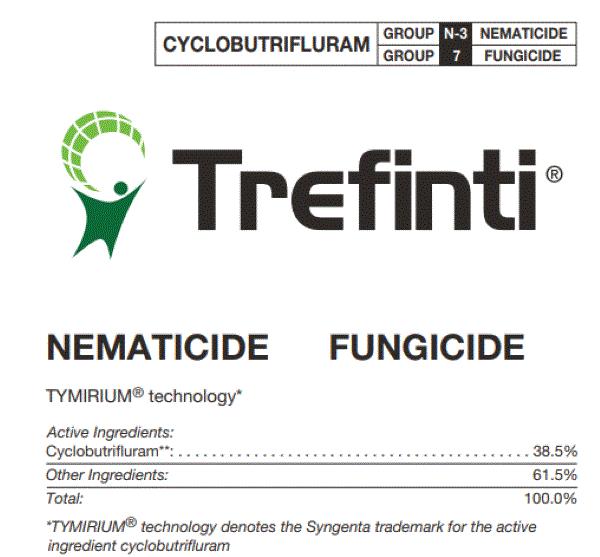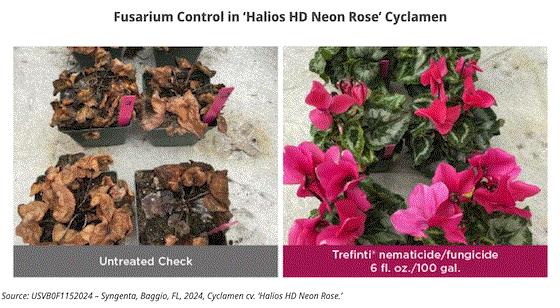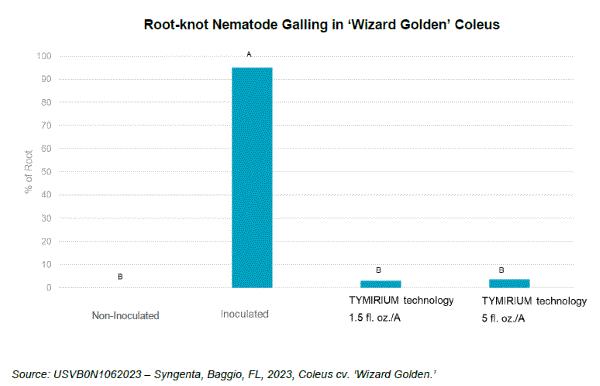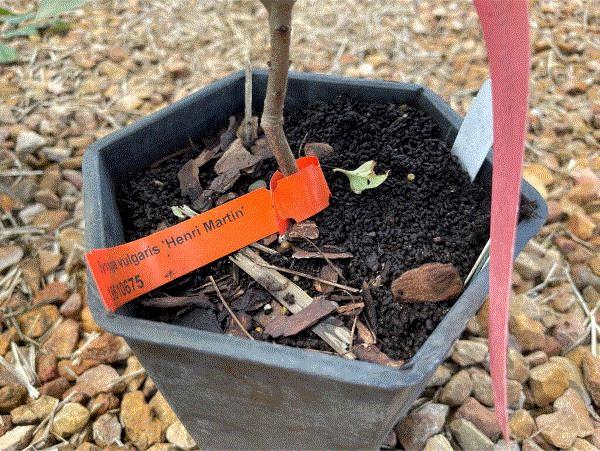The New Trefinti Fungicide/Nematicide
Syngenta has announced that its Trefinti nematicide/fungicide has been granted federal registration. Trefinti also received registration approval in 16 states, with more state approvals expected.
Trefinti contains 38.5% cyclobutrifluram, which is a novel active ingredient for the turf and ornamental market. Cyclobutrifluram, called TYMIRIUM technology by Syngenta, is both a fungicide in FRAC Group 7 and a nematicide in FRAC Group N-3. Trefinti is a welcomed addition to our arsenal, because we have very few options for management of root and foliar nematodes on ornamental plants.
Trefinti can be used in greenhouses, nurseries, interior and exterior landscapes, conifer nurseries, Christmas tree plantations and various commercial, recreational and residential turf sites.

Ornamental diseases listed on the label include root-knot nematodes, foliar nematodes (suppression), soil-borne pathogens (Fusarium), and stem and foliar pathogens (Alternaria, Botrytis, Cercospora, Corynespora, various species of powdery mildew, Diplocardon or rose black spot, Sclerotinia and Septoria). The application rates for these diseases are 3.8 to 6.4 fl. oz. per 100 gal. by drench or 3.8 to 6.4 fl. oz. per acre if applied by broadcast or chemigation. There’s an annual limit of 12.8 fl. oz. per acre per crop (i.e. two applications at the high rate).
The restricted-entry interval (REI) is 12 hours. Required personal protective equipment (PPE) seems pretty standard—shoes plus socks, chemical-resistant gloves, and long-sleeved shirts and pants for applicators and other handlers or coveralls for early entry workers.
Go HERE to find the label, states where this product is registered, and other information about Trefinti.

How Well Does it Work?
Trefinti is formulated as a suspension concentrate. It’s a systemic fungicide with both preventive and control efficacy against a wide range of fungal diseases and nematodes. Trefinti is currently registered for drench, soil-directed broadcast and chemigation application only. According to Syngenta, Trefinti is absorbed by roots and translocated throughout the canopy, which can then provide protection against foliar nematodes and listed foliar diseases. Such protection against diseases must be done preventively; that is, the drench application should be done before symptom development.
Perhaps your biggest question right now is, “How well does it work?” Well, can I answer, “More time is needed for a comprehensive assessment of product efficacy.” I know that sounds like company talk but it’s true.
The first time I heard about TYMIRIUM technology (i.e. cyclobutrifluram) was at the IR-4 Environmental Horticultural Program research priority setting meeting in early October. Juliana Baggio, a R&D scientist from Syngenta’s Vero Beach, Florida, campus, provided an update on the new active ingredient at the meeting. This product is still in an early stage of open testing. I could only show you what had been shared by Syngenta via its press release because I couldn’t get my hand on data from IR-4 (research hasn’t started yet) and other independent researchers. Hopefully, I’ll be able to share more data as research projects evaluating Trefinti are carried out in the coming years.


Juliana conducted an experiment on the efficacy against fusarium in cyclamen. The photos above showed that Trefinti applied at 6 fl. oz. per 100 gal. was effective in preventing death of cyclamen. Juliana conducted another experiment on Trefinti’s efficacy against root-knot nematode on coleus. The second experiment also showed very good efficacy of Trefinti applied at 1.5 fl. oz. and 5 fl. oz. per acre in reducing the percentage of roots showing galling symptoms caused by root-knot nematode infestation. Trefinti was applied as drench in these experiments. It isn’t clear how frequently or when the product was applied.
Again, go HERE for more information, including trial data, on Trefinti.

An Interesting Protein-Based Fungicide to Keep an Eye On
I gave a symposium talk at the annual meeting of the Entomological Society of America in Portland, Oregon, two weeks ago. The paper was about innovations and challenges in floricultural pest management. You and I know perfectly well that there’s no way anyone can do a fair review of the history of innovations and challenges in our industry since the beginning of time. Certainly not me, when I had only 15 minutes to talk. So, I had to be very picky about what I covered in my talk.
One of the challenges I’d identified in the talk is the slowing pace of the introduction of truly new active ingredients or modes of action to floriculture. That means we need to be extra vigilant with our stewardship of current products (such as through pesticide rotation and IPM practices) so that the pesticides we have now remain effective for many years to come. To me, any introduction of novel pesticides, whether they are from my own company or from a competitor (such as Trefinti above), is something to be celebrated.
There is one such novel product I’m keeping my eyes on. Biotalys, a Belgium-based company, announced that EPA has proposed the approval of its Evoca biofungicide for botrytis and powdery mildew management in fruit and vegetable crops.
Now, y’all may ask, What’s the big deal?
Evoca is a protein-based biofungicide. The approach of discovering new active ingredients through protein or biochemical screening and modification has gained quite a bit of momentum in the past few years, and I find it very interesting.
Biotalys isn’t the only company working in this realm. Vestaron has already introduced GS-omega-kappa-Hxtx-Hv1a as a bioinsecticide (Spear-T and a series of products based on this peptide) several years ago. Traditional pesticide manufacturers are paying attention and partnering with smaller companies like these to develop new pest management tools.
Evoca is a result of Biotalys’ AGROBODY Foundry, which is a mechanism of discovering and refining biologically active proteins, peptides and antibodies for plant and food protection uses. Evoca has its start from immune responses of Ilama to extract of fusarium. After going through several phases of breaking apart the molecules, amplification, selection, refinement and characterization, ASFBIOF01-02 polypeptide is developed into a biofungicide (a.k.a. Evoca) and submitted to EPA for approval. (Go HERE if you’re interested in scientific reading on how AGROBODY Foundry works, how Evoca was developed, and how safe and effective Evoca is. Biotalys’ Evoca page also contains lots of information.)
ASFBIOF01-02 polypeptide is placed under a new FRAC Group, F10. EPA approval for Evoca is currently on-going, but I think it’ll likely be approved. If the registration is granted, Evoca will be another option for managing botrytis and powdery mildew. More importantly, Evoca will be a novel mode of action to include in rotation programs.
I look forward to Evoca’s registration and launch. I’ll let you know when this biofungicide is available to the market.

Controlling Jumping Worms in Nursery
As 2025 is winding down and the spring crop season has yet to begin, I want to introduce y’all to a few new research papers that I couldn’t squeeze into the earlier issues of this newsletter. I hope your eyes didn't glaze over as soon as I mention “research.” I promise they’ll be fun, or at least useful.
Let’s start with jumping worm, shall we?
Y’all know jumping worms, right? This group of invasive earthworm species had become quite a bit of concern to nurseries, particularly in the northern half of the United States. The jumping worms are called the jumping worms because they thrash about violently when handled. They’re a concern not because of their peculiar behavior but also how they can change ecosystems by altering soil structure and nutrient cycle. Jumping worms consume organic materials and deposit their wastes as castings, which are pelletized and greatly alter the soil texture. Castings can also change the texture of potting media.

Pelletized castings of jumping worms piled on top of a container. (Source: HortTechnology 35(5): 802-809.)
Jumping worms are a problem without a solution. No pesticide is currently registered to control them; after all, they’re earthworms. So, what in the world can you do if you have jumping worms and don’t want to pass them on to your clients (thus ruining your reputation) in the containerized plants you produce?
Jenna Simon, together with her colleagues and advisors at the University of Minnesota, conducted a couple of experiments to identify pesticides that can be used for managing jumping worms in containers. The report was published in Volume 35, Issue 5 (October 2025) of HortTechnology.
Before I talk in a little more details about the experiments, I want to reiterate one important point: The products Jenna and her colleagues had tested ARE NOT currently registered for managing jumping worms. So, do not take the results from the experiments as recommendations. If jumping worm is a big concern and management is deemed necessary, I suggest that you explore the possibility of 2(ee) registration, special local need registration (24c), or limited permission to use the effective products in your state or county.
Alright, now that my behind is covered, let’s see about the experiments conducted at the University of Minnesota Horticultural Research Center in Chaska, Minnesota. (I had to look on the map to find out where Chaska is. I can’t say I know Minnesota. Turns out it's just 21 miles southwest of the Twin Cities.)
In the first experiment, containers were filled with Gertens container mix (40% pine, 30% compost, 20% peat moss, 10% topsoil), planted with a sugar maple whip, and each infested with six adult jumping worms collected nearby. Eight treatments were applied as drench or granular broadcast: BotaniGard 22 WP (Beauveria bassiana) at 1 oz. per gal., Castaway Tea Seed Meal Fertilizer (contains saponins) at 1 oz per container, Cedarcide cedarwood oil at 0.2 fl. oz. per gal., Conserve SC (spinosad) at 0.06 fl. oz. per gal., Root Cleaner (sodium lauryl sulfate + soybean oil) at 1 fl. oz. per gal., Sevin (zeta-cypermethrin) at 2.8 fl. oz. per gal., Slug Magic (pulverized iron phosphate and spinosad) at 0.5 oz per # 1 container, and T-Bird 4.5L (thiophanate-methyl) at 0.2 fl. oz. per gal.
(Now, I know some of you will send me an email saying, “Hey, you’re wrong, man. Sevin is carbaryl, not zeta-cypermethrin.” Hate to tell ya, but the over-the-counter Sevin today isn’t the Sevin you and I knew in the past—at least not since 2018.)
The first experiment showed that only Sevin and T-Bird achieved greater than 80% mortality in jumping worms four weeks after the application. No other treatments achieved significant mortality compared to the water check.
The plant species was changed to white oak in the second experiment, while other conditions remained the same. In this experiment, T-Bird, Castaway Tea Seed Fertilizer, Slug Magic and Sevin were reevaluated. Two weeks later, Jenna and team found that (again) only T-Bird and Sevin provided greater than 80% mortality in the jumping worm cohorts. Castaway achieved about 11% mortality.
Results from the two experiments are pretty clean-cut: only zeta-cypermethrin (Sevin) and thiophanate-methyl (T-Bird), both at very high application rates, are effective in killing adult jumping worms. I can’t say I’m surprised by the potential of a pyrethroid and thiophanate-methyl; they’d been murmured as potential options when I worked with earthworms in turf system.
I’m despaired by the lack of more options. Tea seed meals and fertilizers containing saponins were some of the most effective products in native and European earthworm casting management in turf. Unfortunately, these products don’t seem to perform well against invasive earthworms of Amynthas species. Carl Redmond and colleagues from the University of Kentucky also reported that saponins didn’t seem effective against another Amynthas species, the green stinkworm, in turf. But several combinations of neonicotinoids and pyrethroids were effective in reducing castings in Carl’s study.
Jenna’s project is the first step in finding solutions for jumping worms in nursery production. Hopefully, future studies will identify more options and instruct us on how to integrate chemical and cultural control practices in dealing with jumping worms.
Want to see more of Jenna’s article? Go HERE for a free copy.





See y'all later!

JC Chong
Technical Development Manager at SePRO
Adjunct Professor at Clemson University
This e-mail received by 27,847 subscribers like you!
If you're interested in advertising on PestTalks contact Kim Brown ASAP!